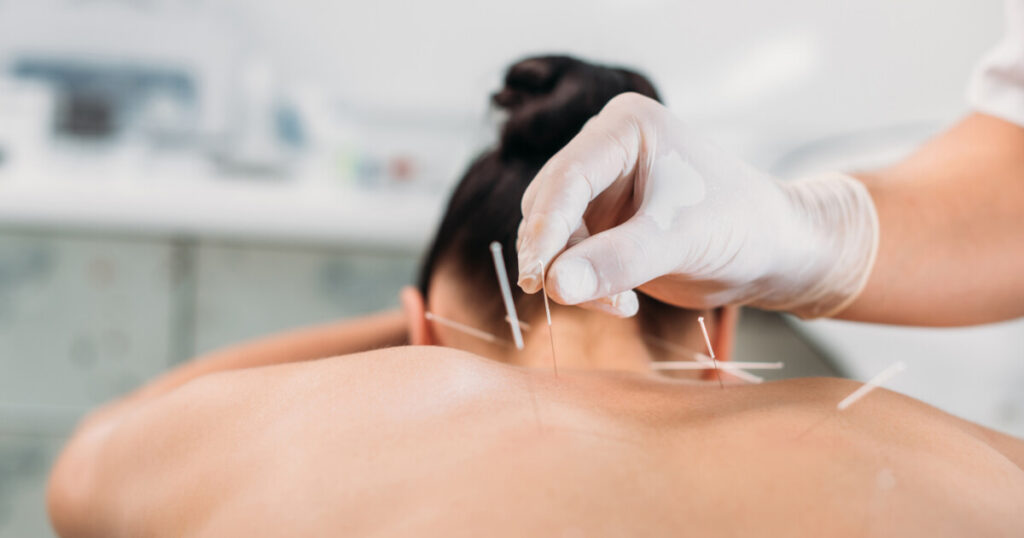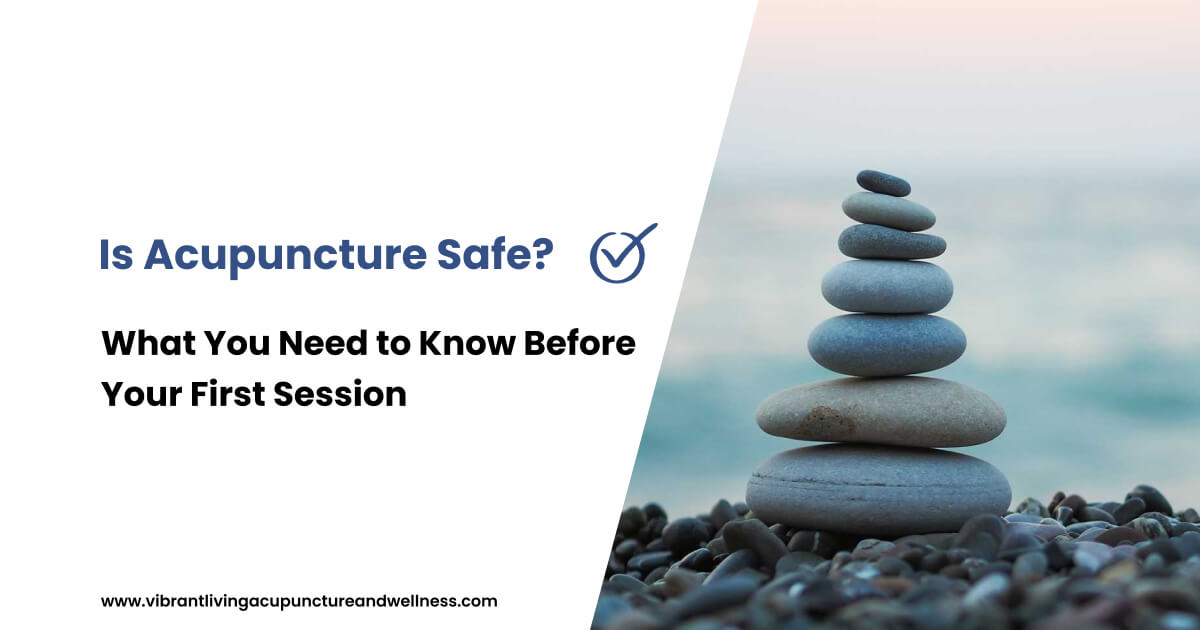If you’re new to acupuncture or curious about how it works, one of the first questions that often arises is: “Is acupuncture safe?”
The immediate answer is: Yes.
When performed by a licensed, trained professional using sterile techniques, acupuncture is considered a very safe and low-risk form of healthcare.
Beyond the short answer, in this blog, we’ll explore:
- Why is acupuncture generally safe?
- What side effects (if any) are expected?
- Who should avoid or modify treatment?
- How to choose a safe and reputable practitioner?
What is Acupuncture, Exactly?
Acupuncture is a form of Traditional Chinese Medicine (TCM) that has been practiced for over 2,000 years. It involves inserting very fine, sterile needles into specific points on the body to stimulate healing, relieve pain, and promote balance in the body’s energy systems.
In modern medicine, acupuncture is used to treat a wide variety of conditions — from back pain and migraines to anxiety, insomnia, and digestive disorders. The needles trigger physiological changes, including improved blood flow, endorphin release, and nervous system regulation.
Why Acupuncture Is Considered a Safe Treatment Option
When performed correctly, acupuncture treatment is regarded as one of the safest forms of complementary healthcare. Its growing popularity across both Eastern and Western medicine is a testament to its well-established safety profile. Below are the key reasons why acupuncture is widely accepted as safe and effective.
✅ 1. Sterile, Single-Use Acupuncture Needles
Modern practitioners use thin, sterile acupuncture needles that are pre-packaged and single-use, eliminating virtually all risk of infection or cross-contamination. In fact, in states like California, clinics must adhere to OSHA standards that regulate how acupuncture needles are stored, used, and discarded. These guidelines ensure that practitioners perform acupuncture using clean needle insertion techniques in a highly sanitary environment.
Additionally, the FDA regulates acupuncture needles as medical devices, further enhancing patient safety.
✅ 2. Trained and Licensed Practitioners Who Practice Acupuncture Responsibly
Licensed acupuncturists are required to complete years of education and hands-on clinical training before they are permitted to practice acupuncture. Their education includes topics such as anatomy, physiology, clean needle technique, and an in-depth understanding of acupuncture points and meridians. They also learn how to properly assess conditions that acupuncture may help treat, such as low back pain, anxiety, and hormonal imbalances.
Most importantly, they are taught how to reduce the risks of acupuncture while maximizing the benefits of acupuncture through personalized care.
✅ 3. Minimally Invasive Technique Using Thin Needles
One of the key reasons acupuncture is so safe is that it’s minimally invasive. The acupuncture needles used are thinner than a human hair, allowing for virtually painless needle insertion. Unlike surgical procedures or more aggressive interventions, acupuncture does not involve cutting, incisions, or medication.
Because the inserting needles technique stimulates the body’s natural healing mechanisms, including the central nervous system, without causing trauma, most people find the experience both gentle and restorative.
✅ 4. Few and Mild Side Effects with Acupuncture
While any healthcare treatment carries the potential for side effects, those associated with acupuncture are typically mild and short-lived. These may include minor bruising, light soreness, or a temporary feeling of fatigue following treatment. These reactions are a normal part of the body’s healing process, indicating that the effects of acupuncture are at work.
Compared to pharmaceutical or surgical interventions, the risks of acupuncture are minimal, making it a popular choice for those seeking pain relief and wellness support through natural, complementary therapies. We’ll explore these mild side effects in more detail next, so you know what to expect after your session.
✅ 5. Backed by Leading Medical and Health Organizations
Acupuncture is not only a respected form of Traditional Chinese Medicine, but also widely endorsed by respected medical bodies. The World Health Organization (WHO) and the National Institutes of Health (NIH) both recognize acupuncture as a valid treatment for various conditions, including chronic pain, low back pain, migraines, and nausea.
With more physicians recommending acupuncture as part of integrative care plans, it’s clear that this ancient therapy continues to earn credibility in Western medicine.
What Side Effects Might You Experience?
Although acupuncture is generally safe, it can still cause some sensations or reactions. Most side effects are mild and temporary, and often part of the body’s natural healing response. Here are a few common ones:
Minor Bleeding or Bruising at the Needle Site
It’s rare, but you might notice a tiny spot of blood or a small bruise where the needle was inserted. This is usually minor, painless, and clears up quickly.
Soreness or Tenderness After Treatment
Especially after deep-muscle or trigger-point acupuncture, you may experience localized soreness, similar to post-workout muscle fatigue. This typically fades within 24–48 hours.
Fatigue or Drowsiness
Some people feel deeply relaxed or even sleepy after acupuncture. This is a sign that your nervous system is shifting into rest-and-repair mode. It’s best to take it easy afterward if you can.
Emotional Release or Sensitivity
Occasionally, people experience emotional responses during or after a session, ranging from tearfulness to euphoria. This can be a healthy release as your body and mind reprocess stuck energy.
These side effects are generally short-lived and a natural part of the body’s healing response.
Who Should Be Cautious With Acupuncture?
Acupuncture is generally considered safe for most individuals, including children, pregnant women, and the elderly. However, there are a few considerations:
Bleeding disorders or blood thinners
People with clotting disorders (like hemophilia) or on blood thinners may bruise more easily. Let your acupuncturist know in advance so they can use extra caution.
Pregnancy
Acupuncture is often helpful during pregnancy for nausea, back pain, and labor prep. However, certain points are contraindicated during pregnancy, so it’s crucial to work with a practitioner trained in prenatal care.
Learn more about Vibrant Fertility Acupuncture.
Pacemakers or medical implants
If electroacupuncture is being used (a technique where a gentle electrical current is applied to needles), people with pacemakers should avoid this modality unless cleared by a physician.
Infections or open wounds
Acupuncture should not be performed on open wounds, infected skin, or areas of inflammation.
Always provide your practitioner with a complete medical history so they can adjust your treatment safely and effectively.
How to Choose a Safe Acupuncturist

Not all acupuncture is created equal. To ensure a safe and effective experience, be sure to choose a qualified, licensed practitioner.
Here’s what to look for:
Proper Credentials
In the U.S., look for the L.Ac. (Licensed Acupuncturist) designation. Also, check if they are certified by the NCCAOM (National Certification Commission for Acupuncture and Oriental Medicine).
Clean, Professional Clinic
The treatment room should be clean, private, and organized. Needles should be opened from sterile packaging in front of you.
Clear Communication
A good acupuncturist will take the time to understand your concerns, explain the process, and answer any questions. You should feel safe, seen, and respected.
Positive Reviews
Check online reviews or get referrals from trusted sources. Word of mouth is often the best way to find a safe, experienced practitioner.
Why Safety is Also About the Environment
One of the underrated safety features of acupuncture is the emotional and mental space it creates. Unlike rushed doctor visits, acupuncture sessions are often quiet, restorative, and non-invasive.
Many patients report that the act of slowing down and being still for 30-45 minutes in a calm environment is healing in itself. The nervous system relaxes, stress hormones lower, and your body gets the chance to reset.
Final Thoughts: Why Acupuncture Safe Practices Support Gentle and Effective Healing
If you’re looking for a safe, natural, and effective approach to healing, acupuncture is a powerful option. It’s backed by ancient tradition, supported by modern research, and practiced around the world with strong safety standards.
While minor side effects are possible, serious complications are exceedingly rare — especially when you’re treated by a skilled, licensed professional.
Whether you’re seeking relief from pain, stress, anxiety, or simply want to feel more balanced, acupuncture offers a safe space to support your body’s natural healing wisdom.
This post is part of my acupuncture “Frequently Asked Questions Series.” Stay tuned… the next blog will walk you through what you might expect during an Acupuncture session.


